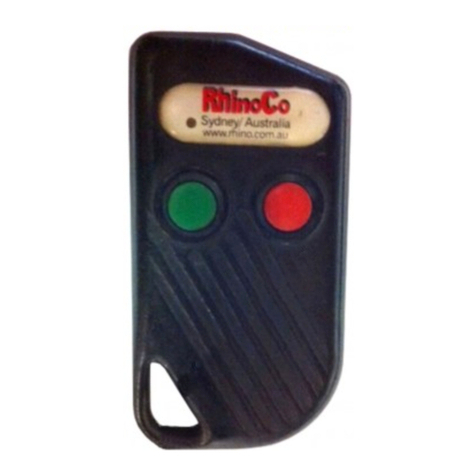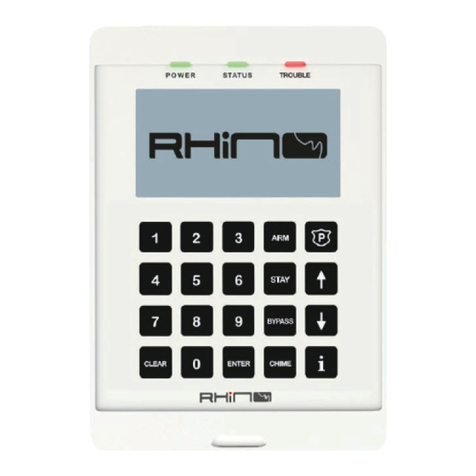
How to Change REGISTER 2:
Vehicle Set Up: DRIVER’S DOOR OPEN, BONNET CLOSED, AND THE IGNITION TURNED ON LAST
Remote Keyaction : TURN ON / OFF FEATURES VIA THERIGHT BUTTON ON THE REMOTE
PROGRAMMABLE
FEATURE Press
Remote This
Many Times
INITIAL
FACTORY
SETTING
DESCRIPTION
Left Button Used For Another
Vehicle 1OFF Allows your remote keys to be divided to act like two
separate single button remote keys to control two
separate vehicles. Simply “teach” the remote into the
other vehicle as detailed in section “learning new
transmitters”. Only right button features can be
accessed. (i.e. boot release control is unavailable).
Second Button Used To
Arm/Disarm This Vehicle 2OFF Turn this feature on in your second vehicle (not this
alarm system) if you are utilising the above feature.
Third Button Used To
Arm/Disarm This Vehicle 3OFF Contact your Rhino Dealer if this feature is required.
Optional 3 Button Remotes are available.
Fourth Button Used To
Arm/Disarm This Vehicle 4OFF Contact your Rhino Dealer if this feature is required.
Optional 4 Button Remotes are available.
Silent Operation 5OFF When on, this feature stops the siren from sounding.
The alarm will still trigger, flashing the indicators etc.
Indication via optional paging system may be desired
instead of siren noise.
Valet Mode 6OFF When on, this feature allows five engine starts before
the system returns to its normal operation ie if you
take the vehicle to valet parking, and you normally use
passive arming, they will be able to start the car 5 times
before passive arming re-engages.
Central Closure 7OFF When on, the lock & unlock outputs become a 15
second negative pulse instead of 0.5 seconds. This
feature is for certain vehicles with vacuum central
locking or those with a central closure wire (some
BMW, Mercedes) ie doors lock, electric windows
wind up, sunroof closes automatically.
Auto Immobilise 8 OFF Enables the alarm system to act as an engine
immobiliser only. The immobiliser activates 38 seconds
after the ignition is turned off. The dash mounted LED
will stay on constantly to confirm the system’s special
status. The vehicle can not be started unless the remote
is pressed. If the remote is pressed again, the alarm will
arm & lock the doors as per normal operation.
Particularly useful feature for tradespeople.
Installer Mode 9SELECT
The Mode
Required
After pressing the remote 9 times to enter this mode,
turn the ignition to off. This mode allows the installer /
owner to verify that each trigger of the alarm system is
working, without having to arm & disarm the system
each time & set off the siren. The siren will beep and
the blinkers will flash to indicate a trigger eg push the
bonnet switch, open a door, hit the vehicle. The siren
will beep four times to indicate a pre-warning impact
sensor detection, or once to indicate full alarm trigger
level. Turn the ignition to on to exit this mode.




































